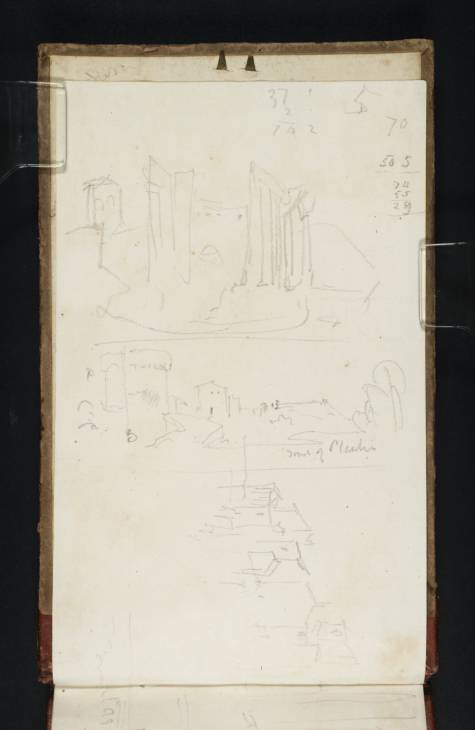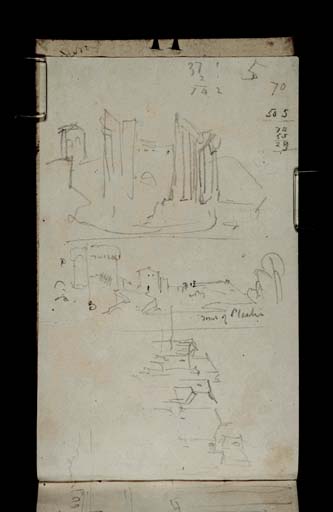Joseph Mallord William Turner The Temple of Vesta at Tivoli; the Tomb of the Plautii from Ponte Lucano; and ?A View of Tivoli 1819
Image 1 of 2
Joseph Mallord William Turner,
The Temple of Vesta at Tivoli; the Tomb of the Plautii from Ponte Lucano; and ?A View of Tivoli
1819
Joseph Mallord William Turner 1775–1851
Folio 1 Verso:
The Temple of Vesta at Tivoli; the Tomb of the Plautii from Ponte Lucano; and ?A View of Tivoli 1819
D14934
Turner Bequest CLXXIX 1 a
Turner Bequest CLXXIX 1 a
Pencil on white wove paper, 186 x 112 mm
Inscribed by the artist in pencil ‘37 . | 7 . | 74 2’ [as a sum] and ‘5’ and ‘70’ and ‘50 5’ and ‘74 | 5.5 | 29 ’ [as a sum], top right. Also ‘P’ and ‘Tomb of Plautii’ within central sketch
Inscribed by the artist in pencil ‘37 . | 7 . | 74 2’ [as a sum] and ‘5’ and ‘70’ and ‘50 5’ and ‘74 | 5.5 | 29 ’ [as a sum], top right. Also ‘P’ and ‘Tomb of Plautii’ within central sketch
Accepted by the nation as part of the Turner Bequest 1856
References
1909
A.J. Finberg, A Complete Inventory of the Drawings of the Turner Bequest, London 1909, vol.I, p.526 as ‘Ponte Lucano and the tomb of the Plautii, and the Temple of the Sibyl’.
1984
Cecilia Powell, ‘Turner on Classic Ground: His Visits to Central and Southern Italy and Related Paintings and Drawings’, unpublished Ph.D thesis, Courtauld Institute of Art, University of London 1984, p.172 note 10.
1987
Cecilia Powell, Turner in the South: Rome, Naples, Florence, New Haven and London 1987, p.76 note 11.
There are three separate sketches on this page, all of which relate to Turner’s trip to Tivoli in the autumn of 1819.
The study at the top represents the so-called Temple of Vesta, a famous classical ruin synonymous with Tivoli. The remains of this circular, peripteral structure stand at the edge of the gorge on the northern side of the town popularly known as the Valle d’Inferno (Valley of Hell). Turner studied the monument from various angles and also repeatedly depicted it in relation to its surroundings. This drawing shows the most ruined half of the temple looking towards the inner cella, or inner chamber. For a full discussion of the Temple and a complete list of sketches see folio 3 verso (D14938).
As Turner’s inscription indicates, the central sketch depicts the Tomb of the Plautius family (or Tomb of the Plautii), a cylindrical first-century funerary monument of Travertine stone, which stands on the Via Valeria, approximately two miles west of Tivoli. When travelling on the road from Rome to Tivoli it was one of the first sights to relieve the featureless plain of the Campagna, and, in conjunction with the adjacent Ponte Lucano, it represented a popular subject for artists. Turner himself made over twenty variant studies during his visit to Tivoli, see folio 27 verso (D14975). The twenty-mile journey would have been covered by carriage. However, the large number of sketches of the bridge and Plautian tomb indicates that Turner was afforded enough time to fully explore the site from a number of different angles, on foot, as well as from the road. He also transcribed the Roman inscription commemorating the construction of Ponte Lucano which he found on a tomb near the Plautian sepulchre, see folio 1 (D14933). Turner would already have been very familiar with the picturesque properties of the site. As a young man, he had copied a watercolour of the tomb from the collection of his patron, Dr Thomas Monro (see Dr Monro’s Album of Italian Views, Tate D36419; Turner Bequest CCCLXXIII 6). Furthermore, he had also made a thumbnail copy of the relevant plate from John ‘Warwick’ Smith’s Select Views in Italy (1792–9), in the Italian Guide Book Sketchbook (see Tate D13966; Turner Bequest CLXXII 19, third from bottom left).
The sketch at the bottom of the page is drawn parallel with the gutter of the sketchbook and is almost certainly a view of Tivoli. It depicts a row of buildings which appear to lie across the top of a steep drop and may include the Temple of Vesta on the far left-hand side.
Nicola Moorby
December 2009
How to cite
Nicola Moorby, ‘The Temple of Vesta at Tivoli; the Tomb of the Plautii from Ponte Lucano; and ?A View of Tivoli 1819 by Joseph Mallord William Turner’, catalogue entry, December 2009, in David Blayney Brown (ed.), J.M.W. Turner: Sketchbooks, Drawings and Watercolours, Tate Research Publication, December 2012, https://www


